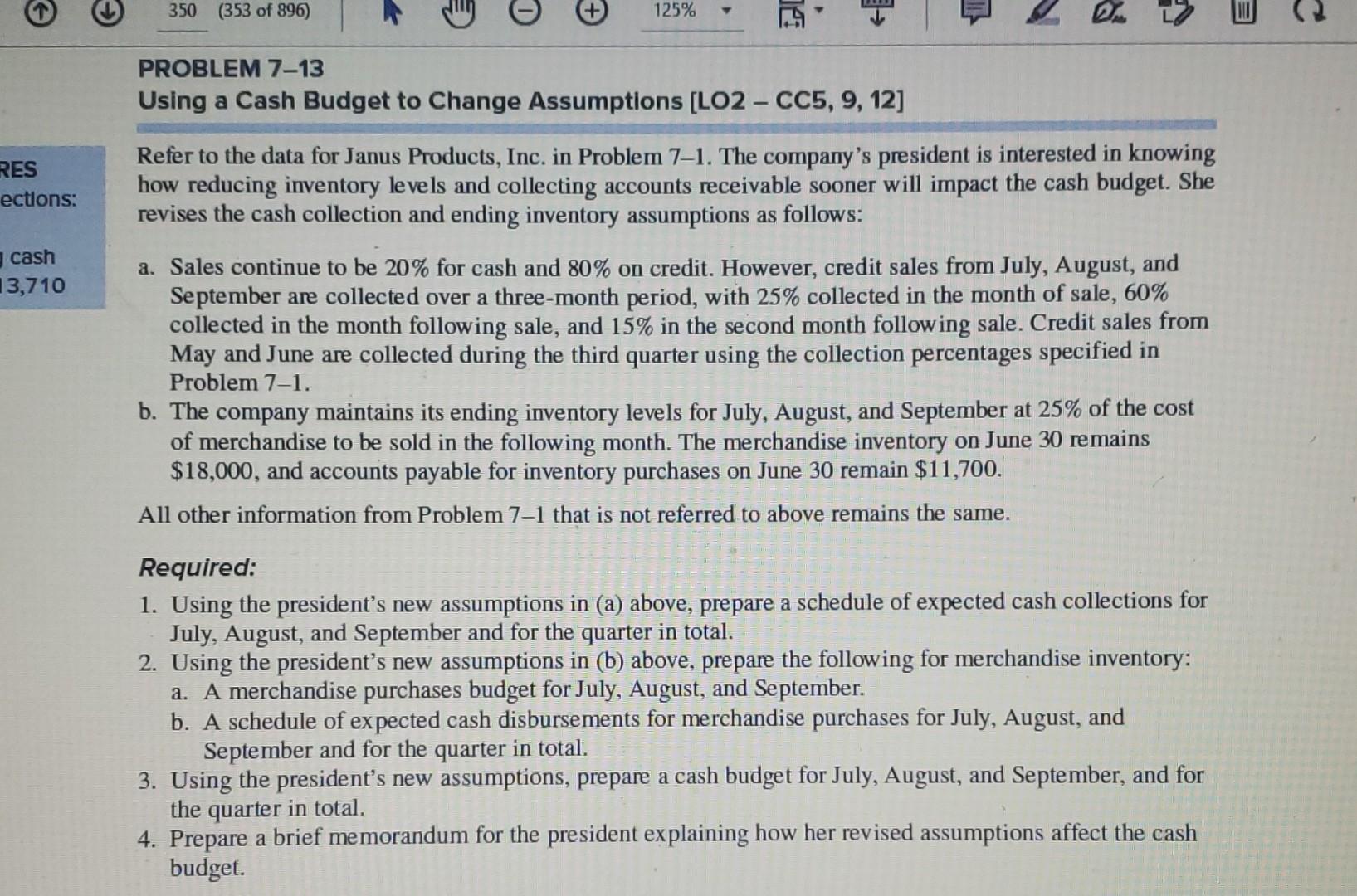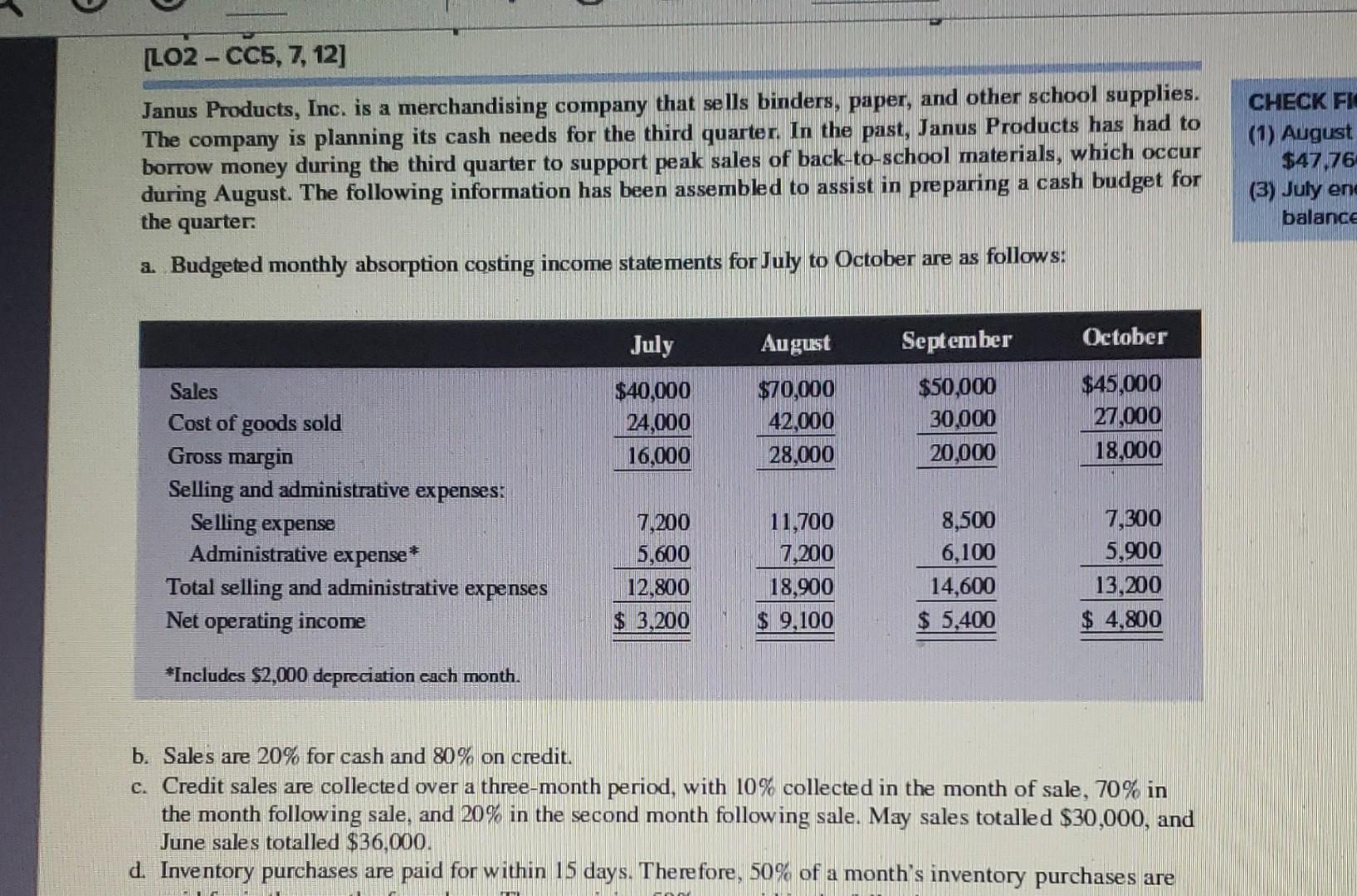Question
PROBLEM 7-1 Preparing a Schedule of Expected Cash Collections and a Cash Budget Janus Products, Inc. is a merchandising company that sells binders, paper, and
PROBLEM 7-1 Preparing a Schedule of Expected Cash Collections and a Cash Budget Janus Products, Inc. is a merchandising company that sells binders, paper, and other school supplies. The company is planning its cash needs for the third quarter. In the past, Janus Products has had to borrow money during the third quarter to support peak sales of back-to-school materials, which occur during August. The following information has been assembled to assist in preparing a cash budget for the quarter: a.Budgeted monthly absorption costing income statements for July to October are as follows: July August September October sales. 40000 70000 50000 45000 cost of goodss sold. 24000 42000 30000 27000 gross margin. 16000 28000 20000. 18000 selling and admin expense selling expense. 7200. 11700. 8500. 7300 administrative. 5600. 7200. 61000. 5900 total sell&admin exp. 12800 18900. 14600. 13200 net operating income 3200. 9100. 54000. 4800
b.Sales are 20% for cash and 80% on credit. c.Credit sales are collected over a three-month period, with 10% collected in the month of sale, 70% in the month following sale, and 20% in the second month following sale. May sales totalled $30,000, and June sales totalled $36,000. d.Inventory purchases are paid for within 1 5 days. Therefore, 50% of a month's inventory purchases are paid for in the month of purchase. The remaining 50% are paid in the following month. Accounts payable for inventory purchases at June 30 total $11 ,700. e.The company maintains its ending inventory levels at 75% of the cost of the merchandise to be sold in the following month. The merchandise inventory at June 30 is $18,000. f.Land costing $4,500 will be purchased in July. g.Dividends of $1,000 will be declared and paid in September. h.The cash balance on June 30 is $8,000; the company must maintam a cash balance of at least this amount at the end of each month. i.The company has an agreement with a local bank that allows it to borrow in increments of $1 ,000 at the beginning of each month, up to a total loan balance of $40,000. The interest rate on these loans is 1% per month, and for simplicity, we will assume that interest is not compounded. The company would, as far as it is able, repay the loan plus accumulated interest at the end of the quarter. continuation of
Refer to the data for Janus Products, Inc. in Problem 71. The company's president is interested in knowing s: how reducing inventory levels and collecting accounts receivable sooner will impact the cash budget. She revises the cash collection and ending inventory assumptions as follows: a.Sales continue to be 20% for cash and 80% on credit. However, credit sales from July, August, and September are collected over a three-month period, with 25% collected in the month of sale, 60% collected in the month following sale, and 15% in the second month following sale. Credit sales from May and June are collected during the third quarter using the collection percentages specified in Problem 71. b.The company maintains its ending inventory levels for July, August, and September at 25% of the cost of merchandise to be sold in the following month. The merchandise inventory on June 30 remains $18,000, and accounts payable for inventory purchases on June 30 remain $11 ,700. All other information from Problem 71 that is not referred to above remains the same. Required: l. Using the president's new assumptions in (a) above, prepare a schedule of expected cash collections for July, August, and September and for the quarter in total. 2.Using the president's new assumptions in (b) above, prepare the following for merchandise inventory: a.A merchandise purchases budget for July, August, and September. b.A schedule of expected cash disbursements for merchandise purchases for July, August, and September and for the quarter in total. 3.Using the president's new assumptions, prepare a cash budget for July, August, and September, and for the quarter in total. 4.Prepare a brief memorandum for the president explaining how her revised assumptions affect the cash budget.



Refer to the data for Janus Products, Inc. in Problem 7-1. The company's president is interested in knowing how reducing inventory levels and collecting accounts receivable sooner will impact the cash budget. She revises the cash collection and ending inventory assumptions as follows: a. Sales continue to be 20% for cash and 80% on credit. However, credit sales from July, August, and September are collected over a three-month period, with 25% collected in the month of sale, 60% collected in the month following sale, and 15% in the second month following sale. Credit sales from May and June are collected during the third quarter using the collection percentages specified in Problem 7-1. b. The company maintains its ending inventory levels for July, August, and September at 25% of the cost of merchandise to be sold in the following month. The merchandise inventory on June 30 remains $18,000, and accounts payable for inventory purchases on June 30 remain $11,700. All other information from Problem 7-1 that is not referred to above remains the same. Required: 1. Using the president's new assumptions in (a) above, prepare a schedule of expected cash collections for July, August, and September and for the quarter in total. 2. Using the president's new assumptions in (b) above, prepare the following for merchandise inventory: a. A merchandise purchases budget for July, August, and September. b. A schedule of expected cash disbursements for merchandise purchases for July, August, and September and for the quarter in total. 3. Using the president's new assumptions, prepare a cash budget for July, August, and September, and for the quarter in total. 4. Prepare a brief memorandum for the president explaining how her revised assumptions affect the cash budget. Janus Products, Inc. is a merchandising company that sells binders, paper, and other school supplies. The company is planning its cash needs for the third quarter. In the past, Janus Products has had to borrow money during the third quarter to support peak sales of back-to-school materials, which occur during August. The following information has been assembled to assist in preparing a cash budget for the quarter. a. Budgeted monthly absorption costing income statements for July to October are as follows: CHECK FI (1) August $47,76 (3) July en balance b. Sales are 20% for cash and 80% on credit. c. Credit sales are collected over a three-month period, with 10% collected in the month of sale, 70% in the month following sale, and 20% in the second month following sale. May sales totalled $30,000, and June sales totalled $36,000. d. Inventory purchases are paid for within 15 days. Therefore, 50% of a month's inventory purchases are b. Sales are 20% for cash and 80% on credit. c. Credit sales are collected over a three-month period, with 10% collected in the month of sale, 70% in the month following sale, and 20% in the second month following sale. May sales totalled $30,000, and June sales totalled $36,000. d. Inventory purchases are paid for within 15 days. Therefore, 50% of a month's inventory purchases are paid for in the month of purchase. The remaining 50% are paid in the following month. Accounts payable for inventory purchases at June 30 total $11,700. e. The company maintains its ending inventory levels at 75% of the cost of the merchandise to be sold in the following month. The merchandise inventory at June 30 is $18,000. f. Land costing $4,500 will be purchased in July. g. Dividends of $1,000 will be declared and paid in September. h. The cash balance on June 30 is $8,000; the company must maintain a cash balance of at least this amount at the end of each month. i. The company has an agreement with a local bank that allows it to borrow in increments of $1,000 at the beginning of each month, up to a total loan balance of $40,000. The interest rate on these loans is 1% per month, and for simplicity, we will assume that interest is not compounded. The company would, as far as it is able, repay the loan plus accumulated interest at the end of the quarter
Step by Step Solution
There are 3 Steps involved in it
Step: 1

Get Instant Access to Expert-Tailored Solutions
See step-by-step solutions with expert insights and AI powered tools for academic success
Step: 2

Step: 3

Ace Your Homework with AI
Get the answers you need in no time with our AI-driven, step-by-step assistance
Get Started


